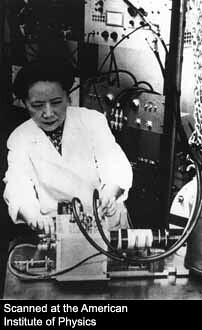Schrödinger's Kitten
Irreverent Science for Everyone
Madame Wu: Breaking Parity, Demonstrating Equality
(Originally posted 24 March 2010)
It's Ada Lovelace day! Time to draw attention to women in science — often ignored, never deservedly. My chosen lady is:
吴健雄 — Chien-Shiung Wu (for Demonstrating the Universe is Not Ambidextrous)
Educated in China before the Second World War (with all the hideous sexism and cruelty to everyone that implies: I'm reading Wild Swans at the moment, you should too), Madame Wu travelled to America to continue her studies in Nuclear Physics and was the only Chinese person to work on the Manhattan project, helping develop ways to separate uranium into its different isotopes.
When the global situation had stabilised in the fifties, two other Chinese physicists Wu knew were beginning to doubt one of the laws physicists had always assumed about nature: that it has no dominant hand. A major part of physics (I could say all, but I'm not feeling that brave) comes from finding symmetries, situations in which the universe will behave the same (conservation laws come directly from the world's symmetrical properties: a principle put forward by another stunning woman, Emmy Noether). It had always been assumed the the universe behaved the same in the left-handed direction as in the right-handed direction — spinning anticlockwise was the same as spinning clockwise. This idea is called parity, and the symmetry coming from it is called P-symmetry.
This symmetry had been observed to hold true for particles interacting via the electromagnetic force and the strong nuclear force (the force that holds neutrons and protons, the individual bobbles of the nucleus, together). But there are four fundamental forces, and Lee and Yang, theoretical physicists and acquaintances of Wu, had their doubts about the weak nuclear force's conformity to this rule1. They did their maths and figured it was worth investigating the behaviour of the weak nuclear force — this is the one that covers about how different kinds of particles can turn into each other and holds the atomic nuclei themselves together.
Only problem was, this was a horrifically complicated experiment. Wu was well-known for being a meticulous, hard-working experimenter — her students called her a 'slave driver' and a 'dragon lady' at times — perhaps she could take this on? Chien-Shiung was the world-expert on the research of beta decay (when a neutron changes into a proton by emitting an electron) so this was right up her street. She was scheduled to visit her homeland and go on a lecture tour of Europe that month with her husband, but she decided the experiment was so urgent that it needed to be done NOW, and stayed home. Using cobalt nuclei cooled to 0.01 degrees above absolute zero, she demonstrated that more electrons were given out in one direction than the other, regardless of the direction the nuclei were spinning in. Parity symmetry was busted. As a bonus, so was combined Charge and Parity symmetry — i.e., if you flip the universe as if you were looking at it in a mirror and swap every positive charge for a negative one and vice versa, things don't behave the same either.
Unlike many other professions, scientists are (supposed to be) pleased when what they previously thought turns out to be wrong, so destroying two major assumptions was a big deal. Lee and Yang received the Nobel prize swiftly afterwards for their discovery — Wu got the respect of her peers. This did not, however, come with a cash prize.
Photo from her supervisor, Emile Segré's, visual archives on Flickr.
In subsequent work she provided experimental support to Feynman and Gell-Mann as they looked for similarities in the behaviour of the electromagnetic force and the weak nuclear force. Later, this was developed into the suggestion that these two forces were actually manifestations of the same 'electroweak' force, taking a step closer towards physics' ultimate goal of unification. We want to describe everything with just one idea, because we like things simple. Further experiments took in the behaviour of the ghostly and elusive neutrino, work on time symmetry (does the universe look the same if we run it backwards?), and finished up with work on the chemical reactions involved in sickle-cell anaemia.
Chien-Shiung Wu worked incredibly long hours and expected the same dedication to physics from her students. She particularly encouraged her female students, believing that only by demonstrating our abilities can we achieve parity. Ladies, wannabe scientists, and wannabe scientist ladies, I leave you with this quote from the Chinese Madame Curie herself:
There is only one thing worse than coming home from the lab to a sink full of dirty dishes, and that is not going to the lab at all.
1. Well done, you can count! The missing force is gravity, and no-one knows what the hell is going on with that, let alone if it has a preferred hand. Experiments are proceeding... ←
 RSS feed
RSS feed Twitter feed
Twitter feed
